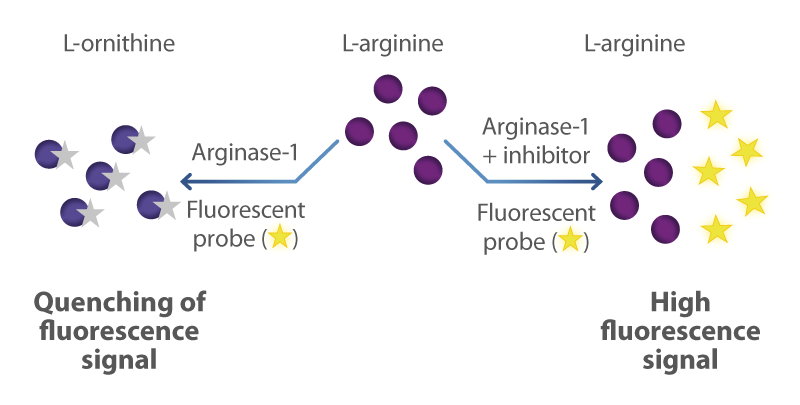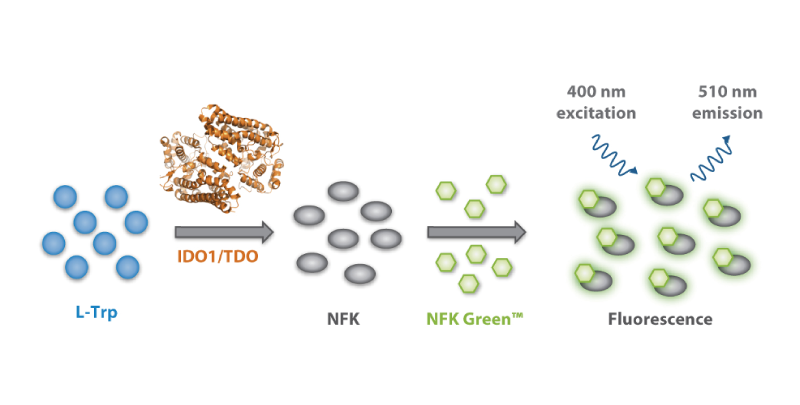Molecular Interactions – Assay Kits
Homogeneous Mix-and-Measure Assay Kits for Cancer Immunotherapy
Biochemical High-Throughput Screening of Cancer Immunotherapy Drug Candidates
Activity Screening of Arginase-1 Using Arginase Gold™
Fluorescence Assay Readouts for the Evaluation of Arginase-1 Activity
Key Features |
Arginase Gold™ |
|---|---|
| Mild reaction conditions | |
| Ambient temperature | |
| Neutral pH | |
| Homogeneous assay format | |
| Few steps before readout, 1.5 hours from start to end | |
| HTS compatible | |
| End-point measurements | |
| Kinetic experiments | |
| Fluorescent readout |
Arginase-1 is an enzyme that converts L-arginine into L-ornithine. Arginase-1 is an important drug target for cancer immunotherapy. The Arginase Gold™ assay technology is based on the detection of Arginase-1 activity with the proprietary probe Arginase Gold™. The fluorescence of the probe is quenched upon conversion of L-arginine into L-ornithine, resulting in a decrease of the fluorescent signal. Arginase Gold™ is a homogenous mix-and-measure (‘addition-only’) assay. Arginine is detected by a single incubation step at room temperature. The assay utilizes a fluorescence-based readout and is robust (Z’-factor > 0.6). Progression of the assay can be followed in real time, allowing for kinetic experiments. Arginase Gold™ was especially developed for use in multi-well plates and for high-throughput screening.
Activity of Tryptophan-Metabolizing Enzymes Using NFK Green™ -GreenScreen™
Fluorescence Assay for the Evaluation of Human and Mouse IDO1 and TDO Activity
|
Catalog No.
|
Datapoints | Cell-based | Biochemical | Contents |
|---|---|---|---|---|
| NTRC-GSCell-1K | 1,000 | Probe; substrate; IDO1 and TDO reference inhibitors | ||
| NTRC-GSCell-10K | 10,000 | idem | ||
| NTRC-hIDO-1K | 1,000 | Probe; substrate; assay buffer; human IDO1 protein; IDO1 reference inhibitor | ||
| NTRC-hIDO-10K | 10,000 | idem | ||
| NTRC-mIDO-1K | 1,000 | Probe; substrate; assay buffer; mouse IDO1 protein; IDO1 reference inhibitor | ||
| NTRC-hTDO-1K | 1,000 | Probe; substrate; assay buffer; human TDO protein; TDO reference inhibitor | ||
| NTRC-hTDO-10K | 10,000 | idem | ||
| NTRC-mTDO-1K | 1,000 | Probe; substrate; assay buffer; mouse TDO protein; TDO reference inhibitor |
Key Features |
NFK Green™ |
|---|---|
| Mild reaction conditions | |
| Ambient temperature | |
| Neutral pH | |
| Homogeneous assay format | |
| HTS compatible | |
| End-point measurements | |
| Fluorescent readout |
Tryptophan metabolism plays an important role in immune modulation and neurodegenerative disease. Tryptophan-metabolizing enzymes are drug targets for cancer immunotherapy and neurodegenerative disease. We have developed NFK Green™ assays for the high-throughput screening of the tryptophan-metabolizing enzymes indoleamine 2,3-dioxygenase (IDO1) and tryptophan dioxygenase (TDO). The NFK Green™ assay works under mild conditions and is suitable for high-throughput screening. The fluorescence assay is based on a highly specific and unique label, developed by NTRC, named NFK Green™. The protocol allows a rapid implementation of the assay for high-throughput screening or regular compound testing.
References
Grobben et al. (2020) High-throughput fluorescence-based activity assay for Arginase-1. SLAS Discovery, 25 (9):1018-1025.
Seegers et al. (2014) High-throughput fluorescence-based screening assays for tryptophan-catabolizing enzymes. Journal of Biomolecular Screening, 19 (9):1266-1274.



